Tagpfauenauge ■ European peacock
Aglais io (Linnaeus, 1758)
Vor einigen Wochen hatte ich auf einer meiner Touren winzige Raupen an Brennnesseln entdeckt. Einte willkommene Gelegenheit, um diesen Tagfalter wieder einmal zu züchten. So eine Zucht eignet sich übrigens auch für Kinder. Sie lernen etwas über den Schmetterling und die Futterpflanze der Raupen. Es gilt auch Verantwortung zu übernehmen und regelmäßig frisches Futter in der Natur zu beschaffen. Die Raupe kann man in Plastikbehälter oder größeren Gläsern sehr gut halten. Täglich sollten die Behälter gereinigt werden. Das alles ist kein Hexenwerk, erfordert aber etwas Zeit und Aufmerksamkeit. Kinder sind schnell fasziniert von der seltsamen Verwandlung und lernen gierig, wie die Natur funktioniert. Das prägt fürs Leben und vermittelt eine verantwortungsvolle Sicht auf die Natur und alles was sie bewirkt.
A few weeks ago on one of my tours I had discovered tiny caterpillars of nettles. A welcome opportunity to breed this butterfly once again. Such a breeding is also suitable for children. They learn something about the butterfly and the caterpillars' food plant. It is also important to take responsibility and regularly obtain fresh food in nature. The caterpillar can be kept very well in plastic containers or larger jars. The containers should be cleaned daily. All this is not witchcraft, but requires some time and attention. Children are quickly fascinated by the strange transformation and learn greedily how nature works. This shapes their lives and conveys a responsible view of nature and everything it does.
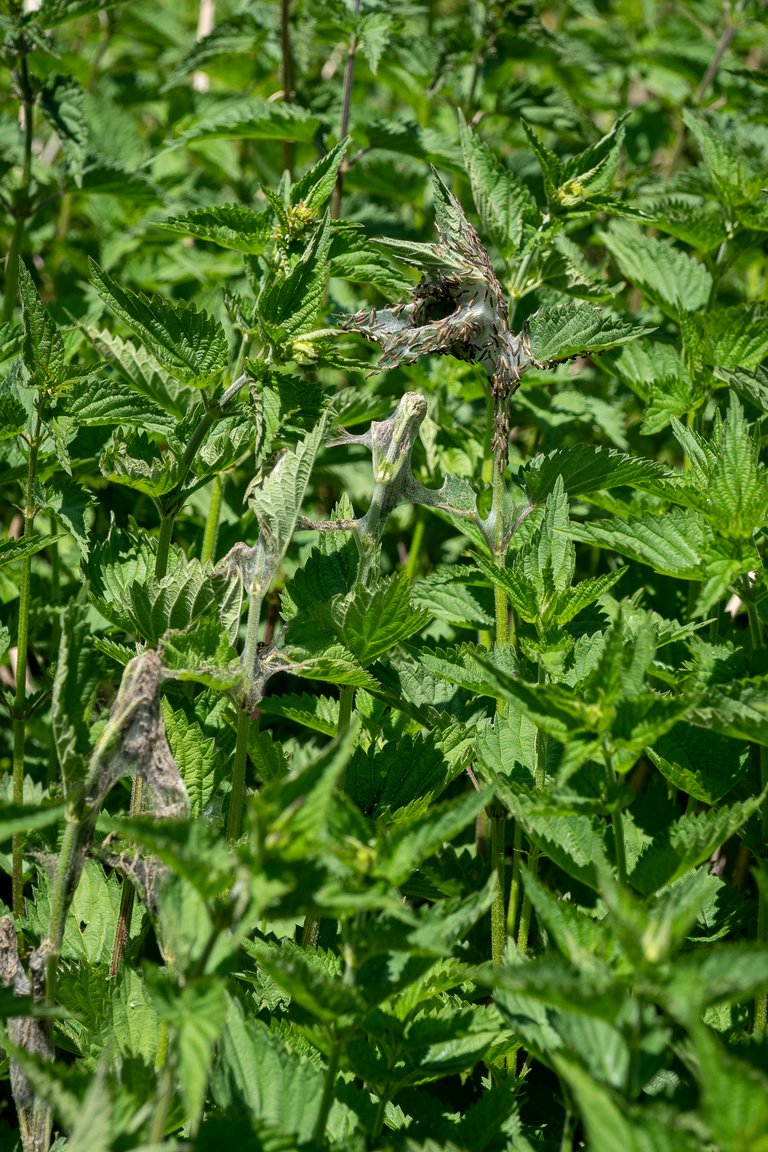
▲ Click on the image for full resolution ▲
Das Weibchen haftet seine Eier an die Blattunterseite von Brennnesselblättern. Bevorzugt werden Pflanzen, die im Halbschatten wachsen. Nach ungefähr 2 Wochen schlüpft aus dem Ei die Raupe. Die geselligen Raupen bilden ein Gespinst, in dem sie in den Fresspausen ruhen. Das Gespinst schützt die Raupen vor Prädatoren. Es kann mit zunehmender Entwicklung der Raupen die gesamte Pflanze überziehen. Brennnesseln sind überall reichlich verfügbar, sodass einer Reproduktion für das Tagpfauenauge kein Problem darstellt.
The female attaches her eggs to the underside of nettle leaves. Preference is given to plants that grow in semi-shade. After about 2 weeks the caterpillar hatches from the egg. The social caterpillars form a web in which they rest during the feeding breaks. The web protects the caterpillars from predators. It can cover the whole plant as the caterpillars develop. Nettles are abundantly available everywhere, so that reproduction is no problem for the peacock butterfly.
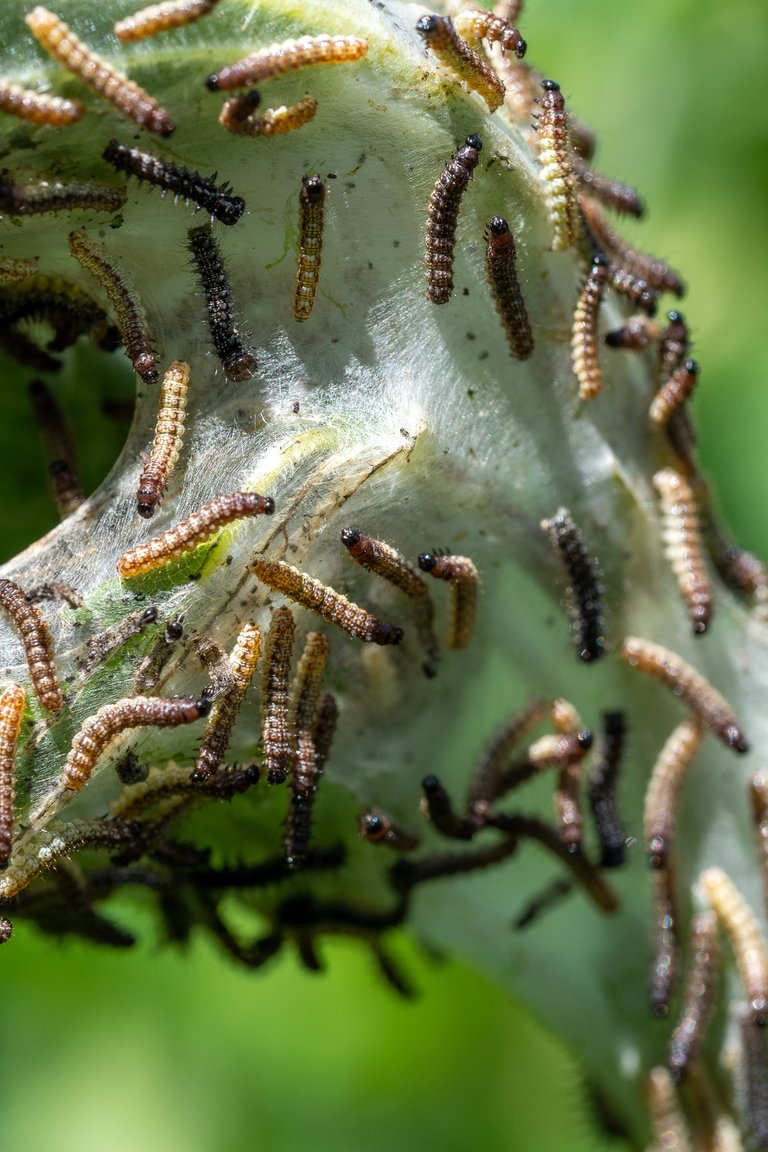
▲ Click on the image for full resolution ▲
Nachdem sich die Raupen mehrfach gehäutet haben, ist der Nahrungsbedarf gewachsen und sie wechseln auf benachbarte Brennnesselpflanzen um zu fressen. Die Raupe hat mit ihrer schwarzen Farbe, den Dornen und kleinen weißen Punkten ihr charakteristisches Aussehen erreicht.
After the caterpillars have shed their skin several times, their need for food has increased and they switch to neighbouring nettle plants to feed. The caterpillar has reached its characteristic appearance with its black colour, thorns and small white spots.
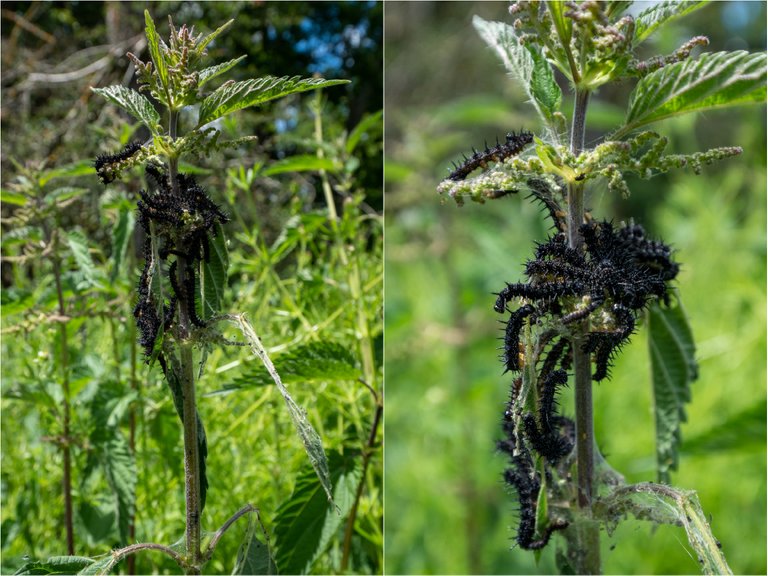
▲ Click on the image for full resolution ▲
Nach der letzten Häutung ist die Raupe bereit für die Metamorphose. Jetzt sucht sie sich im Umfeld einen geeigneten Platz für die Verpuppung. Dort spinnt sie ein Gewebe, an das sie sich mit den hinteren Füßen anheftet. So gesichert beginnt die Raupe mit der faszinierenden Verwandlung zum Schmetterling.
After the last moult, the caterpillar is ready for metamorphosis. Now it looks for a suitable place in the environment for pupation. There it spins a tissue to which it attaches itself with its back feet. Thus secured, the caterpillar begins its fascinating metamorphosis into a butterfly.

▲ Click on the image for full resolution ▲

▲ Click on the image for full resolution ▲
Nachdem die Haut abgestreift wurde, hängt die Puppe zur weiteren Entwicklung kopfüber an einem vertrockneten Stängel. Nach zwei Wochen kann man die Zeichnung der Flügel in der Puppe erkennen. Ein Zeichen, dass die Metamorphose bald abgeschlossen ist. Ein bis zweit Tage später, schlüpft der Falter aus seiner Puppenhülle. Er entfaltet seine Flügel und ist nach ungefähr zwei Stunden bereit für seinen ersten Flug. Während dieser Phase sollte der Schmetterling nicht gestört werde!
After the skin has been stripped off, the pupa hangs upside down on a dried stem for further development. After two weeks, the drawing of the wings can be seen in the pupa. This is a sign that the metamorphosis will soon be completed. One or two days later, the butterfly hatches from its pupa shell. It unfolds its wings and is ready for its first flight after about two hours. During this phase the butterfly should not be disturbed!
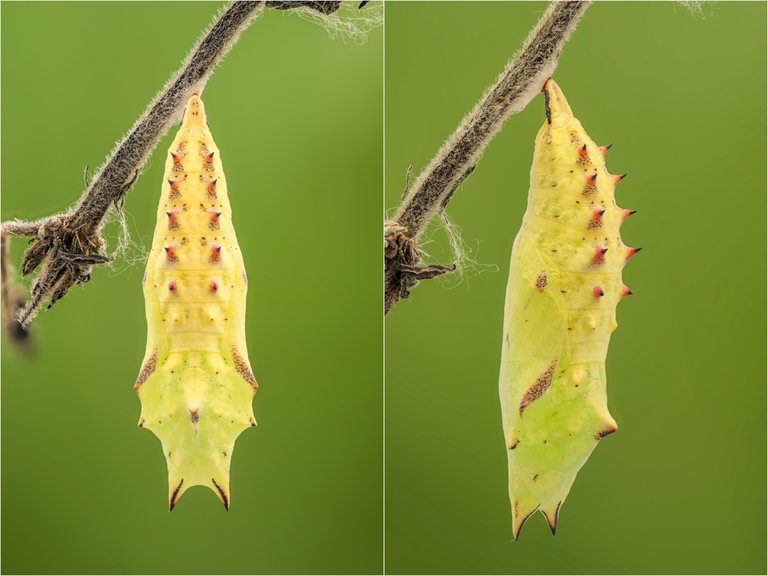
▲ Click on the image for full resolution ▲
So kennen wir ihn alle. Auf der Suche nach Nektar an zahlreichen Blüten. Er ist ein regelmäßiger Besucher im heimischen Garten und ein Blickfang für jeden Naturliebhaber.
We all know him like that. In search of nectar on numerous flowers. It is a regular visitor to the home garden and an eye-catcher for every nature lover.
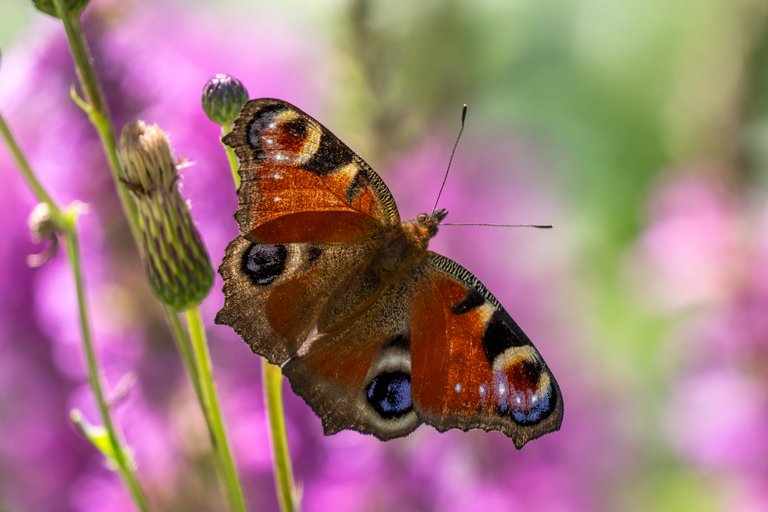
▲ Click on the image for full resolution ▲
Weit weniger spektakulär zeigt sich seine Flügelunterseite. In ruhendem Zustand klappt der Falter seine Flügel zusammen und ist so bestens gegen Fressfeinde geschützt. Er verschmilzt mit seinem Umfeld und ist nur sehr schwer zu entdecken. Wird er von einem Angreifer bedroht, öffnet er ruckartig seine Flügel und zeigt seine Pfauenaugen. Das wirkt auf einen potenziellen Fressfeind abschreckend, sodass dieser die Flucht ergreift.
Far less spectacular is the underside of its wings. When at rest, the butterfly folds its wings and is thus optimally protected against predators. It merges with its environment and is very difficult to detect. If it is threatened by an attacker, it opens its wings jerkily and shows its peacock eyes. This acts as a deterrent to a potential predator so that it flees.
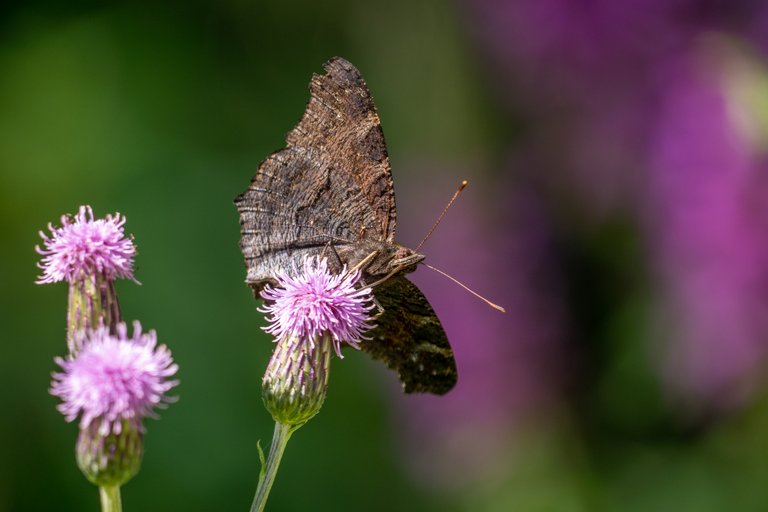
▲ Click on the image for full resolution ▲
Es macht Spaß, den Falter zu beobachten, wie er von Blüte zu Blüte tanzt, um Nektar zu saugen. An allen Stellen flattert, summt und brummt es. Insekten sind einfach faszinierend und bergen noch so viele Geheimnisse.
It is fun to watch the butterfly dancing from flower to flower to suck nectar. Everywhere it flutters, hums and buzzes. Insects are simply fascinating and still hold so many secrets.
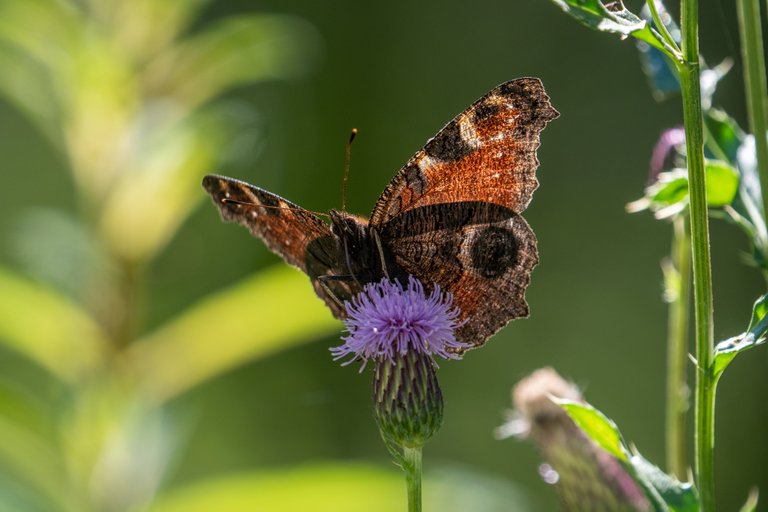
▲ Click on the image for full resolution ▲
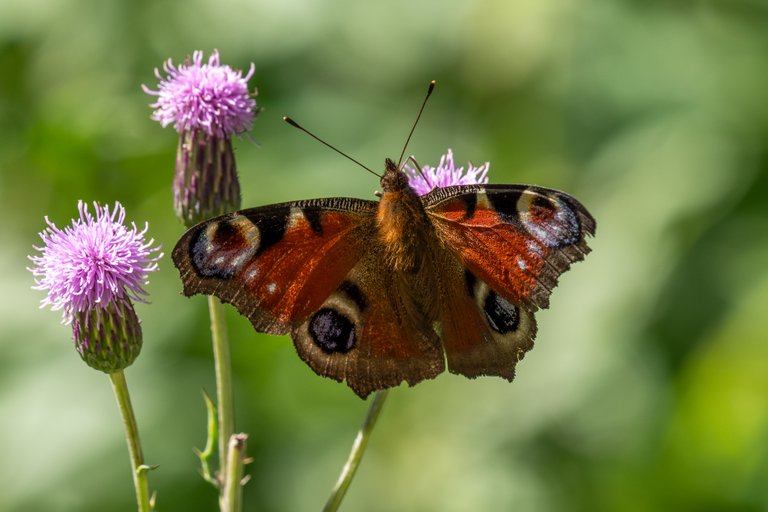
▲ Click on the image for full resolution ▲
Am Morgen genießt das Tagpfauenauge auch schon mal die wärmende Sonne auf einem Waldweg. Dort versorgt es sich mit Mineralien. Das Tagpfauenauge fliegt in zwei Generation. Die zweite Generation überwintert als Schmetterling an einem geschützten Ort und fliegt im darauf folgenden Frühjahr. Der Falter ist noch zahlreich zu beobachten und gilt in seinem Bestand als nicht gefährdet.
In the morning the peacock butterfly enjoys the warming sun on a forest path. There it supplies itself with minerals. The peacock flies in two generations. The second generation hibernates as a butterfly in a protected place and flies the following spring. The butterfly can still be observed in large numbers and its population is not considered endangered.
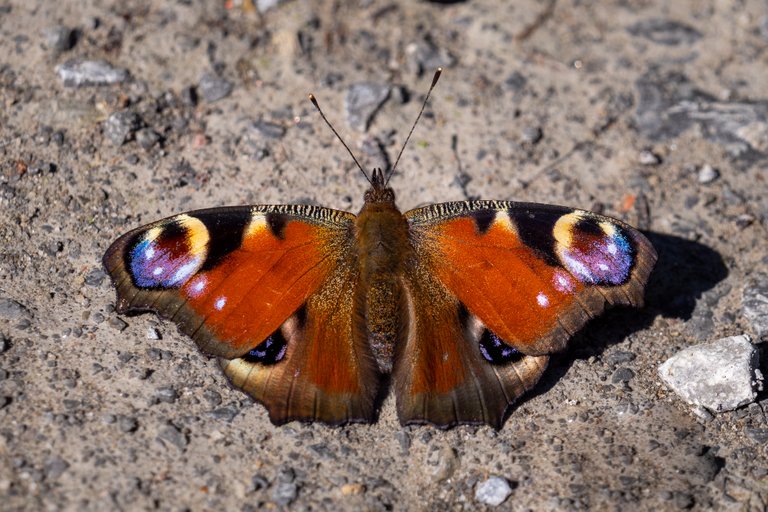
▲ Click on the image for full resolution ▲
In einem früheren Beitrag hatte zur Überwinterung schon einen Beitrag veröffentlicht:
https://peakd.com/deutsch/@faltermann/winterschlaf-hibernation
In an earlier article had already published an article on wintering:
https://peakd.com/deutsch/@faltermann/winterschlaf-hibernation
| Category: | Macro |
| Camera: | Panasonic Lumix DC-G9 |
| Lens: | Olympus M.Zuiko Digital ED 60mm 1: 2.8 Macro + Panasonic Leica DG 100-400mm f4-6.3 Aspherical Power OIS |
| Location: | Germany, Baden Württemberg, Kreuzwertheim + Ebenheid |
Wenn dir mein Beitrag gefällt, freue ich mich über deine Nachricht.
Herzlichen Dank und viele Grüße vom @faltermann 🐛
If you like my contribution, I am looking forward to your message.
Many thanks and greetings from Germany 🦋

Herzlichen Glückwunsch.
Dein Beitrag wurde für den Monatspreis der Liebe im Juli nominiert.
Weiter so!
SEND with LOVE!
Da freue ich mich aber wirklich!
Vielen herzlichen Dank und alles liebe 😍
Starke Bilder! Ich bin immer wieder begeistert wie Du uns die Natur näher bringst.
LG Michael
!invest_vote
!jeenger
Natur ist nun mal meine Leidenschaft und ganz besonders die Insekten haben es mir angetan. Für mich ist es immer wieder faszinierend, die unterschiedlichen Vorgänge in der Natur zu beobachten.
This is a beautiful life cycle of peacock butterfly, its wing colour beautiful, caterpillar is changing with very variety of spot, just its a nature gift.
I couldn't agree more. It's a gift of nature!
Wow Wonderful macro pictures...Actually i feel as if I watch a documentary about butterflies...
Have a nice day my friend...
Many thanks for your great compliment 😃
Wow! Wonderful shots! Again. Congrats dear friend.
!discovery 30
I'm glad you like my pictures again. Thank you very much for your message. 😃
A brilliant set of images explaining the life cycle of this butterfly.
I tried my first time at rearing caterpillars with a Knotgrass Moth (Acronicta rumicis). I didn't plan to do it, but a female laid some eggs while I was moth trapping, and as I had not seen the distinctive caterpillar I thought I would give it a go.
It wasn't as difficult as I had thought although it did take up a lot of my time (I even took them with me on holiday so I could keep feeding them!)
Acronicta rumicis is a very beautiful species where also the caterpillars look great. Breeding is easy, because the caterpillars feed on many different plants. The moth flies with us in Lower Franconia in two generations.
I have just Arctia caja and Phalera bucephala in breeding. A. caja hibernates as caterpillar. Here I have already succeeded in breeding over the winter last year. In any case very difficult and connected with a high loss rate. If you consider that in nature only about 3 moths survive out of 300 eggs, this is definitely a success.
Good luck and a nice evening for you 🦋
Wow very great photography and beautiful butterfly!😎
I appreciate the compliment. Many thanks and best wishes from Germany 🦋
Ich finde das ein interessantes Thema, die Erziehung von Kindern, an die Methode hatte ich nicht gedacht, danke für den ganzen Input.
Kinder sind die Zukunft! Ihre Geister sind noch unverdorben und offen für den Zaber der Natur. Mit ihrer Begeisterung stecken sie die Eltern und Verwandte an und sorgen so für ein positives Bewusstsein!
Ein toller Beitrag. Mich würde nur interessieren, ob Du die Raupen auch zuhause verpuppen lässt oder nach dem Leben im Glas oder der Box wieder in der freien Natur zum Verpupplen aussetzt?
Beste Grüße.
!COFFEEA
Du wurdest als Member von @investinthefutur gevotet!
Herzlichen Dank!
Du hast ein Upvote von mir bekommen, diese soll die Deutsche Community unterstützen. Wenn du mich unterstützten möchtest, dann sende mir eine Delegation. Egal wie klein die Unterstützung ist, Du hilfst damit der Community. DANKE!
Vielen Dank für deinen Support!
This post was shared and voted inside the discord by the curators team of discovery-it
Join our community! hive-193212
Discovery-it is also a Witness, vote for us here
Many thanks for your support!
:) if you like our work, consider using one of your free votes to vote for us as witness!
Ein jeengervote für dich von @mima2606
Vielen Dank für deine Unterstützung!
@mima2606 denkt du hast ein Vote durch @investinthefutur verdient!
@mima2606 thinks you have earned a vote of @investinthefutur !
Votet @cervisia for Witness
Dankeschön!